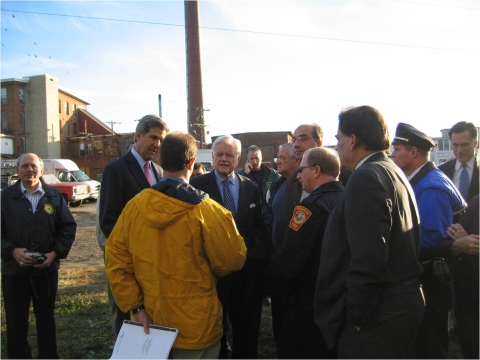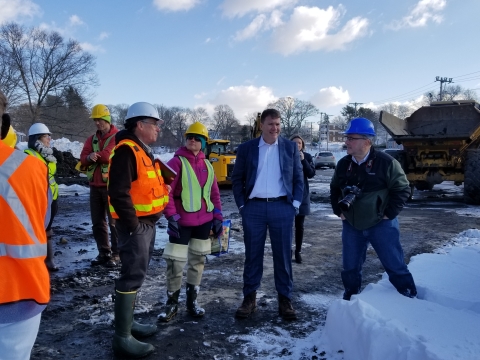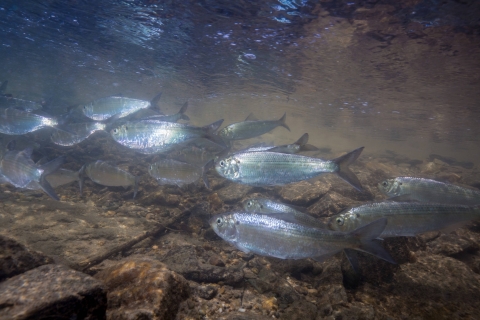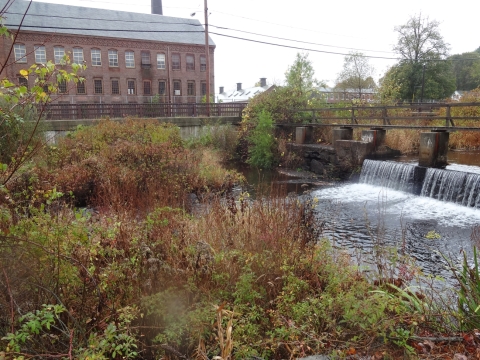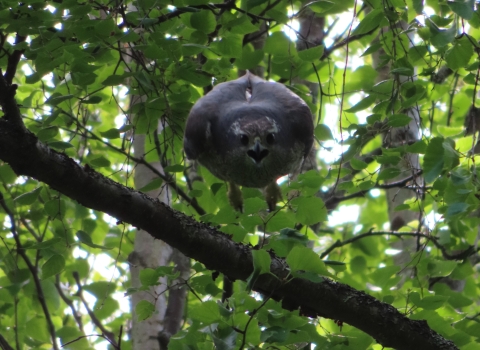The West Britannia Dam was not going down without a fight. Despite persistent prodding by the excavator and a cluster of expectant partners and city officials on the riverbank, the concrete supports stood firm, as they had for nearly 200 years, holding back the Mill River in Taunton, Massachusetts.
The dam finally surrendered the next day, after contractors brought in an industrial saw to cut through the structure structure
Something temporarily or permanently constructed, built, or placed; and constructed of natural or manufactured parts including, but not limited to, a building, shed, cabin, porch, bridge, walkway, stair steps, sign, landing, platform, dock, rack, fence, telecommunication device, antennae, fish cleaning table, satellite dish/mount, or well head.
Learn more about structure ’s base. The excavator could then pry pieces of the dam loose and remove them, letting the river flow freely from Lake Sabbatia to the Taunton River four miles away.
The removal of the dam was a relief for Taunton residents, who had lived with the specter of dam failures for decades, as structures that once harnessed the river’s power fell into disrepair. It was also good news for river herring, which could swim from Narragansett Bay to their spawning grounds above Lake Sabbatia for the first time in centuries.
The stories of Taunton’s fish and its people have long been intertwined. A turning point for both occurred in the early 2000s, setting a course for a brighter future for the Mill River.
A wake-up call heard statewide
In mid-October 2005, after five days of rain, the swollen Mill River threatened to breach the Whittenton Pond Dam, upstream from the West Britannia, and flood downtown Taunton, a half-mile away. The failure could cause a destructive domino effect by relieving downstream pressure holding in place the Morey’s Bridge Dam, and the waters of Lake Sabbatia, still farther upstream.
Rick Ferreira, director of the Taunton Emergency Management Agency, understood the severity of the situation.
“We thought the rain would never stop,” he said. “When I went home on Friday afternoon, I wasn’t sure I’d have an office to return to on Monday morning,”
By Sunday, Ferreira was helping 2,000 Taunton residents flee their homes. Later that night, believing the danger had passed, authorities lifted the evacuation order, only to move 1,000 people out again on Monday.
The second evacuation lasted a week, as crews shored up the Whittenton Dam with rocks and removed its wooden top to reduce water pressure. Governor Mitt Romney, Senators Edward Kennedy and John Kerry and Congressman Barney Frank were all on hand, and the situation received national news coverage. The cost of the crisis, including loss to businesses, totaled more than $1.5 million.
In time, the river retreated to its bed, and the immediate danger passed. Residents and business owners returned to their daily lives. But the Whittenton Dam crisis spotlighted the dangers of obsolete, unmaintained dams, and it spurred change.
“The near-failure of Whittenton Dam in 2005 really brought home the risk of aging dams for New Englanders,” noted Cathy Bozek, the Service’s fish passage fish passage
Fish passage is the ability of fish or other aquatic species to move freely throughout their life to find food, reproduce, and complete their natural migration cycles. Millions of barriers to fish passage across the country are fragmenting habitat and leading to species declines. The U.S. Fish and Wildlife Service's National Fish Passage Program is working to reconnect watersheds to benefit both wildlife and people.
Learn more about fish passage coordinator for the Northeast. “The event led to improved dam safety regulations in Massachusetts and, eventually, a funding source for removing or repairing dams in the state.”
In Taunton, the crisis energized a nascent effort to restore the Mill River. Soon, public and private dam owners, state and federal agencies (including the Service), local and national nonprofits, and the City of Taunton were working together to remove unsafe and obsolete dams on the river and open 30 miles of stream and 400 acres of lakes and ponds to migratory fish.
The Hopewell Mills Dam, the first upstream of the Taunton River, was also the first to be removed in 2012. The remnants of the Whittenton Dam followed in 2013. That same year, the Massachusetts Department of Transportation replaced the Morey’s Bridge Dam, at the outlet of Lake Sabbatia, incorporating a fish ladder. That left the West Britannia as the only obstacle on the river.
In January 2018, the Service finished the Mill River restoration by removing that dam in partnership with The Massachusetts Division of Ecological Restoration and Division of Marine Fisheries, the National Oceanic and Atmospheric Administration, The Nature Conservancy and Acuity Management, which owned the dam. The work was also supported by funding for Hurricane Sandy recovery and resilience.
Thinking back to another crisis with the Whittenton Dam in 1968, when he was 11 years old, Ferreira reflected, “The various agencies, working together, have accomplished more in the last 12 years than was done in the preceding 37. It’s really remarkable.”
From Herring Town to Silver City
The same year as the Whittenton Dam crisis, the Massachusetts Division of Marine Fisheries suspended the harvest of blueback herring and alewife - known jointly as river herring - throughout the state.
Despite their name, river herring spend most of their lives in the ocean, where they’re some of the most popular fish in the sea. Myriad marine animals, from commercial fish to seals and whales, feed on them. Historically, their sheer numbers made coastal rivers run silver when they returned to their inland spawning grounds each spring.
River herring were a staple of Native Americans’ diets, a welcome change from dried and salted meats each spring. Early European settlers also caught the fish and dried them for storage.
Local lore holds that Taunton was once called “Herring Town” for the large fish run in the Mill and Taunton rivers. The fish became popular and valuable as bait, preferred by fish and lobster harvesters and striped bass anglers alike.
In the early 1800s, the Industrial Revolution brought manufacturing to New England. Dams built to run the mills also blocked the way for herring and other migratory fish to reach their upstream spawning grounds, and rivers ran silver no more.
Ironically, with the success of silver manufacturers like Reed & Barton during the 19th century, Taunton became known as “Silver City,” though herring were no longer found in the Mill River. Reed & Barton’s sprawling operation was powered by the West Britannia Dam into the 21st century.
In 1920, when state fisheries biologist David Belding assessed coastal waterways for restoring river herring, he held little hope for the Mill River.
“Since it is badly polluted by manufacturing wastes and obstructed by dams, the reestablishment of the old fishery is an impossibility,” Belding said.
By the late 20th century, habitat degradation, increased take by international offshore harvesters, and uncontrolled incidental catch by domestic commercial fishermen, along with the now-obsolete dams, had caused a dramatic drop in the river herring population throughout New England.
To save the fish, Massachusetts banned the harvest of blueback herring and alewife in state waterways in 2005. The following year, the National Marine Fisheries Service named river herring a Species of Concern.
Making way for migratory fish
With the removal of the West Britannia Dam, the Mill River is now open from the Taunton River — the longest undammed coastal river in New England — to Lake Sabbatia and habitat farther upstream.
“The aging West Britannia Dam was the last significant barrier to fish passage on the river,” said Eric Derleth, the Service’s Partners for Fish and Wildlife Program supervisor in the New England Field Office. “River herring will be able to reach their spawning grounds once more.”
After the Hopewell Mills Dam was removed in 2012, river herring were seen on underwater cameras above the former dam site the following spring, and their numbers nearly quadrupled the next year. The monitoring was funded by the Service’s Office of Conservation Investment, formerly Wildlife and Sport Fish Restoration, and carried out by the Massachusetts Division of Marine Fisheries.
Joseph Machado, III, who lives on the shore of the former impoundment created by the Hopewell Mills Dam, is happy that the West Britannia Dam is gone.
“One time I took my row boat up there, and I saw a pocket of herring stuck downstream of the dam,” he said. “Now, they’ll be able to make it up to Sabbatia.”
Indeed, the spring after the West Britannia Dam was removed, river herring reached Lake Sabbatia for the first time in 200 years. The numbers quickly climbed in succeeding years, and, in 2023, nearly 36,000 were counted at the Morey’s Bridge Dam fish ladder. From Lake Sabbatia, river herring and other fish can access more than 30 miles of streams and ponds.
A crisis with a silver lining
Since the Whittenton Pond Dam crisis, the Massachusetts Division of Ecological Restoration has worked with partners to remove more than 45 dams. The Service is proud to have joined the state on many of those projects, improving the quality of life for Massachusetts residents.
“Removing an obsolete dam does more than release a river — it restores a route for migratory fish to reach their spawning grounds; it opens opportunities for people to enjoy the outdoors; and it allows communities to live without fear of flooding caused by dam failure,” said the Service’s Northeast Regional Director Wendi Weber.
Between 2009 and 2023, the U.S. Fish and Wildlife Service worked with partners to remove more than 900 barriers to fish passage in the Northeast, restoring access to nearly 8,500 miles of river and stream habitat and 61,000 acres of lakes, ponds and wetlands. These efforts contributed more than $5 billion in economic value, through increased tourism and recreation, improved water quality and protection of people and property.
Sara Burns, a water resource scientist with The Nature Conservancy, said of the West Britannia removal, “This restoration project bolsters human health and safety, restores an ecosystem, and conserves an important species.”
In an era of more frequent intense storms caused by climate change climate change
Climate change includes both global warming driven by human-induced emissions of greenhouse gases and the resulting large-scale shifts in weather patterns. Though there have been previous periods of climatic change, since the mid-20th century humans have had an unprecedented impact on Earth's climate system and caused change on a global scale.
Learn more about climate change , the Mill River is more resilient without its aging dams, and more likely to stay within its banks and floodplains, leaving Taunton residents high and dry in all but the most severe weather.
And a restored waterway offers river herring and other migratory fish a fresh start and hope for the future. What seemed impossible 100 years ago may just come to be, and the Mill River might run silver once more.
Note: Sara Burns is no longer with The Nature Conservancy, and Eric Derleth has since retired from the U.S. Fish and Wildlife Service.



